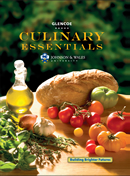
Culinary Essentials ©2010Chapter 15: Cooking TechniquesCheck Your Answers: After You ReadSection 15.1Review Key Concepts1. A dry cooking technique uses oil, fat, the radiation of hot air, or metal to transfer heat. No moisture is used. Any moisture that comes from the food evaporates.2. During cooking, moisture is lost, the food tissue breaks down, and proteins coagulate. The longer proteins are subjected to heat, the firmer and more solid they become. Practice Culinary Academics3. Science Generally, moist and combination (steam, sear/braise) techniques produce a tender texture and keep original color due to the retention of moisture. Dry techniques create a firm texture, and brown the carrots, creating a strong aroma and flavor due to caramelization.4. Social Studies Describe one or more cooking techniques and identify what type of cooking technique it is. Use the information in the book to predict how these techniques will affect food. Discuss the similarities and differences between the techniques from different regions of the world. 5. Mathematics First egg: 12 hard-cooked, 24 overall; probability is 12/24, or ½. Second egg: if the first was hard-cooked, there will be 11 hard-cooked eggs, and 23 overall; the probability of selecting a hard-cooked egg is 11/23. To find the probability of both events, multiply ½ x 11/23 = 11/46. Section 15.2Review Key Concepts1. A griddle is a solid, flat piece of metal with a gas or electric heat source. Griddles are commonly used to make sandwiches, such as grilled cheese and breakfast items, such as pancakes and eggs. Heat the griddle to 350ºF (177ºC), add fat if necessary, and then place the item or items on the griddle. Turn the food to cook all parts of the food.Practice Culinary Academics2. English Language Arts The advice column should offer practical advice for everyday cooks about using dry cooking techniques, such as what carryover cooking is, how to stir-fry, or tips to follow after frying.3. Science The larger and denser the object, the greater the carryover cooking. Larger objects retain heat because they have a lower surface area to volume ratio. Denser objects retain moisture. Water has a higher heat capacity inside the food. The potato, being denser, will take longer to cool. 4. Social Studies Many cooking techniques go as far back as the ancient Egyptians. Changes in the technique occur as equipment is invented or improved that allows more control over the process. Some techniques are used all over the world now, while some places have unique versions of techniques, such as yakitori, or Japanese grilling, that are distinctive. 5. Mathematics The diameter of the pan is 10 inches, so the radius is 5 inches. Total volume of oil is (3.14)(5 in.)(5 in.)(0.5 in.) = 39.25 cu. in. Converted to fluid ounces, the volume is 39.25 × 0.554 = 21.7445, or about 22 fl. oz. Section 15.3Review Key Concepts1. To blanch a food, completely submerge it in a boiling liquid and briefly cook it, and then remove it. Plunge it immediately into ice water to stop the cooking.2. Braising is a process of cooking a food item slowly for a long time in a liquid, after first searing it. It is used to make tough cuts tender. To braise, first sear the food. Then, remove it, and deglaze the pan. Then, return the food to the pan and add liquid. Finally, place the pan in the oven, and cook until tender. Practice Culinary Academics3. Science The Maillard reactions occur when the protein and the sugars on the surface of the meat combine due to the high heat. It causes the meat to brown and the flavor to become stronger. Meat is browned before stewing or braising to make it more flavorful.4. English Language Arts Posters should describe braising using the steps given in this section and should illustrate each step with a drawing, picture, or illustration. Students may want to use the How To feature on braising for ideas on how to format their posters. 5. Mathematics 20 minutes ÷ 3.5 = 5.714286 minutes. 0.714286 is converted into seconds by multiplying 0.714286 × 60 = 42.85714 ≈ 43 seconds. The rice will cook in 5 minutes and 43 seconds. |  |















